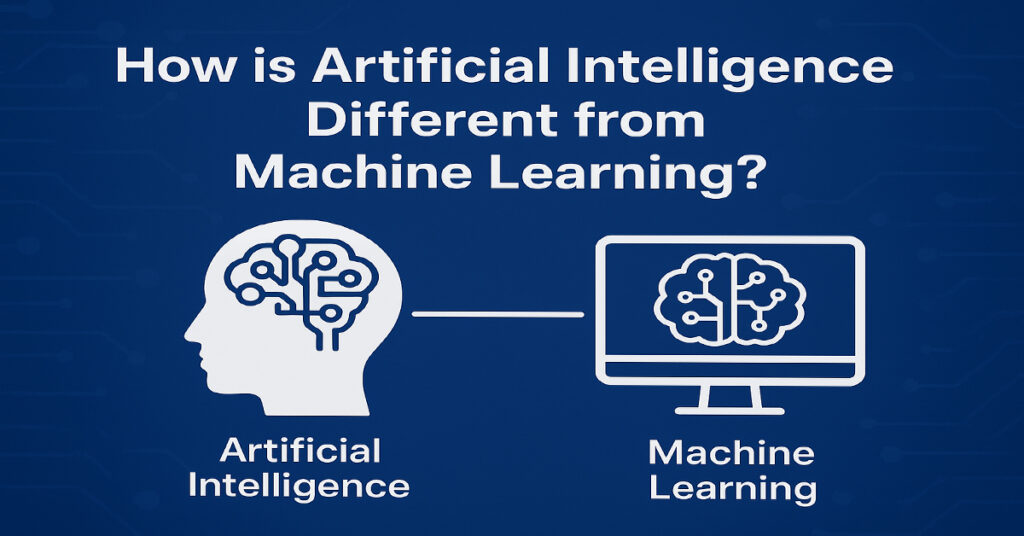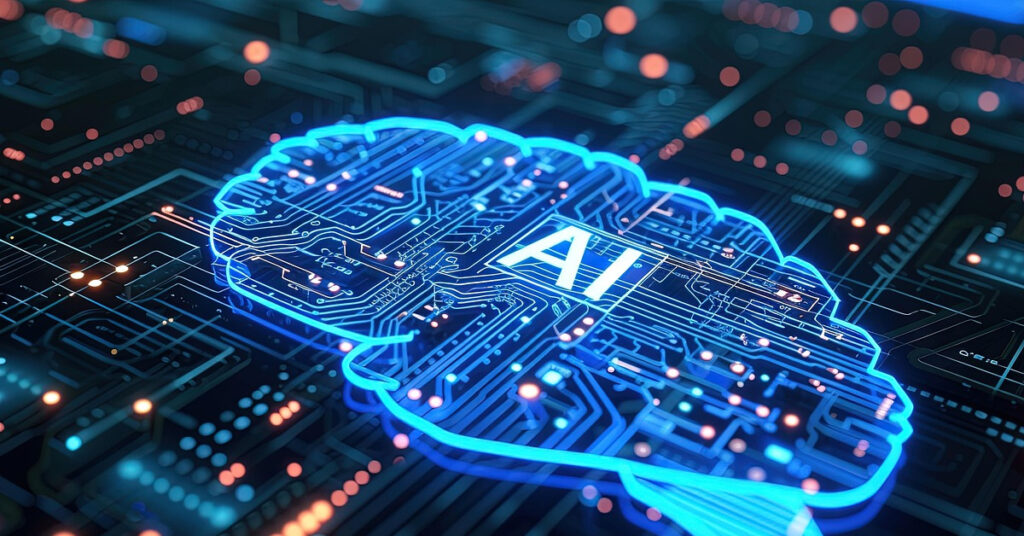How is Artificial Intelligence Different from Machine Learning?

Introduction
Artificial Intelligence (AI) has become one of the most powerful forces shaping the modern digital era. From self-driving cars to voice assistants, AI systems are rapidly transforming industries and daily life. However, one of the most common questions people ask is: how is AI different from machine learning? Although both terms are often used interchangeably, they are not the same. AI is the broader concept of creating intelligent machines, while machine learning is a specific approach that allows these systems to learn from data and improve performance over time.
In this article, we’ll explore the difference between Artificial Intelligence, AI systems, Human intelligence, Machine Learning, Algorithms, Problem-solving, Decision-making, and why understanding these terms is essential in today’s technology-driven world.
What is Artificial Intelligence?
Artificial Intelligence, often shortened to AI, refers to the science of creating machines or systems that can mimic human intelligence. The core goal of AI is to enable machines to perform tasks that would typically require human skills such as:
Understanding natural language
Recognizing patterns in images or voices
Making decisions based on data
Solving complex problems
AI systems go beyond simple automation. Instead of following rigid instructions, they aim to replicate human intelligence in reasoning, problem-solving, and decision-making. For example, a robot that can adapt its movements when encountering obstacles demonstrates artificial intelligence.
Understanding Machine Learning
Machine Learning (ML) is a subset of AI. Unlike traditional programming, where a developer provides every rule, ML enables systems to learn from data. This means the machine doesn’t need to be told exactly what to do—it finds patterns, learns from examples, and makes predictions or decisions.
For instance:
A spam filter learns to identify unwanted emails by analyzing millions of previous examples.
A recommendation system on Netflix or YouTube suggests content based on your viewing history.
Banking apps detect fraudulent transactions by learning patterns of unusual behavior.
The key idea is that machine learning allows AI systems to improve performance automatically as they receive more data.
AI Systems vs. Human Intelligence
One of the fascinating aspects of AI is its attempt to mimic human intelligence. However, there are key differences:
Speed & Scale: AI systems can analyze massive datasets faster than humans.
Learning Ability: Humans learn through experience and emotions, while machines learn strictly from data and algorithms.
Decision-making: Humans consider emotions, ethics, and context, while AI focuses on logic and statistical accuracy.
This comparison highlights that while AI systems are powerful, they are not a replacement for human intelligence but rather a complementary tool to extend human capabilities.
The Role of Algorithms in AI and Machine Learning
At the heart of both AI and machine learning lies the algorithm—a set of rules or instructions that guide how a system processes information.
In AI, algorithms are used for reasoning, natural language processing, robotics, and vision systems.
In machine learning, algorithms are the foundation for training models on datasets. These algorithms adjust and refine themselves as more data is introduced, making the system smarter over time.
Some common machine learning algorithms include:
Decision Trees
Neural Networks
Support Vector Machines
Clustering Algorithms
Algorithms act as the engine driving the intelligence of these systems.
Problem-Solving and Decision-Making with AI
One of the biggest advantages of AI systems is their ability to tackle problem-solving and decision-making at scale.
Problem-Solving: AI can diagnose diseases, optimize supply chains, or even assist in scientific research by analyzing data faster than humans ever could.
Decision-Making: Machine learning models help businesses decide pricing strategies, detect risks, and improve customer service by predicting future behaviors.
Unlike humans, AI doesn’t get tired, biased, or distracted, which makes it ideal for industries that demand precision. However, ethical considerations remain important when machines make decisions that affect human lives.

Key Differences Between AI and Machine Learning
To put it simply:
Artificial Intelligence is the broader concept: machines that can act intelligently.
Machine Learning is a subset of AI: systems that learn from data to become more accurate over time.
AI focuses on mimicking human intelligence, while ML focuses on using data and algorithms to make systems smarter.
Think of AI as the umbrella term, and machine learning as one of the most important tools under that umbrella.
Why Understanding the Difference Matters
Knowing the difference between AI and machine learning is more than just technical knowledge—it has real-world impact:
Businesses can better apply the right technology to improve efficiency.
Students and professionals can choose the right career paths in AI or ML.
Consumers can understand how digital products like recommendation engines or chatbots actually work.
As AI continues to grow, machine learning will remain the driving force behind innovations in healthcare, finance, education, transportation, and entertainment.
Conclusion
Artificial Intelligence and Machine Learning are deeply connected but not the same. AI is the science of making machines act with intelligence, while Machine Learning is the method that allows these machines to learn from data and improve performance. By using algorithms, AI systems can perform problem-solving and decision-making tasks that mimic human intelligence but with far greater efficiency.As we move into the future, the relationship between AI and machine learning will only grow stronger, shaping how we live, work, and interact with technology. Understanding these differences helps us appreciate the power of intelligent systems and their potential to transform the world.
Frequently Asked Questions (FAQs)
1. What is the main difference between Artificial Intelligence and Machine Learning?
AI is the broader concept of creating intelligent machines, while ML is a subset of AI that enables systems to learn from data.
2. Why is Machine Learning called a subset of AI?
Because ML is one approach within AI that focuses specifically on data-driven learning and self-improvement of systems.
3. How do AI systems mimic human intelligence?
AI systems replicate human-like skills such as reasoning, problem-solving, and decision-making, but without emotions or biases.
4. What role do algorithms play in AI and Machine Learning?
Algorithms provide the rules and instructions that allow AI systems and ML models to analyze data, learn patterns, and make predictions.
5. Can AI make decisions better than humans?
AI can process vast data quickly and make logical decisions, but unlike humans, it lacks emotional understanding and ethical judgment.
6. How does Machine Learning improve performance over time?
By analyzing large amounts of data, ML models continuously refine their accuracy, making better predictions and smarter decisions.
7. What are real-life examples of AI and Machine Learning?
Examples include voice assistants like Siri, fraud detection in banking, personalized recommendations on Netflix, and self-driving cars.